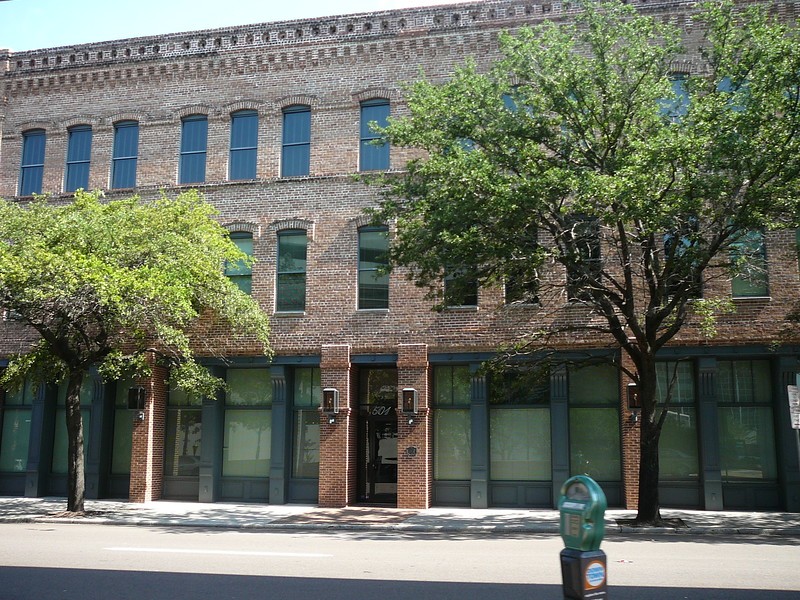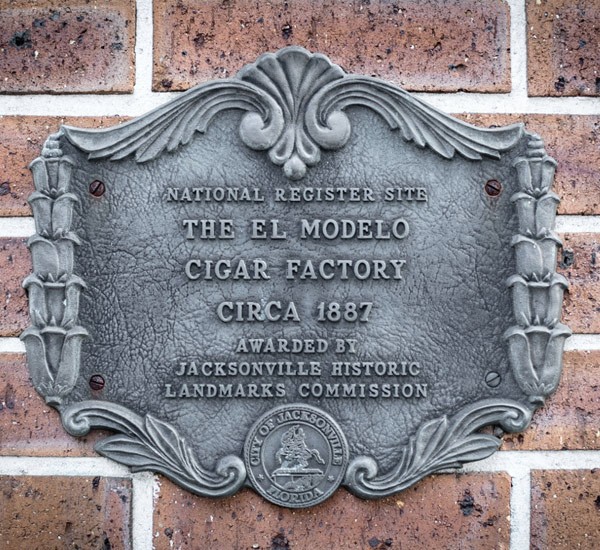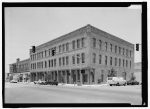El Modelo Cigar Factory (1890-1898)
Introduction
Text-to-speech Audio
Images
The former El Modelo Cigar Factory.

The plaque that remains on "El Modelo Block," granted by the Jacksonville Historic Landmarks Commission.

The former El Modelo Cigar Factory around 1933.

The former El Modelo Cigar Factory around 1933.

Backstory and Context
Text-to-speech Audio
El Modelo Cigar Factory was the largest in Jacksonville at a time when cigar-making was one of the area's largest employers. The factory moved into the building three years after the building’s construction between 1886 and 1887. Sustained by a large Cuban population in Jacksonville, this was one of the major centers of support for Cuban revolutionaries. There ere fifteen cigar factories in the city by 1895 and together they produced around six million hand-rolled cigars per year. El Modelo was the largest of the factories and employed 225 workers with an annual payroll of around $145,000-$147,000 and workers receiving anywhere from $9 to $35 per week. Under general management and then ownership of Gabriel Hidalgo Gato, the company garnered worldwide attention for a variety of cigars such as “La Tropica,” “El Modelo,” “Hamlet,” “La Capitalo,” “El Deicite,” and the “Florida Alligator.”
Cigars in the factory were manufactured on the third floor of the three-story brick building and they were sold on the second floor; however, the factory was not just known for making headway in one of the most profitable industries in the city. Gato’s brother-in-law, Jose Alejandro Huau, was an agent of the Cuban Revolutionary Party and Cuban Political Club in Jacksonville. He assisted the founder of Cuba’s Revolutionary Party, Jose Marti, in eight trips to Jacksonville to gain support and money for the organization. On December 23, 1893, he gave a speech at El Modelo Cigar Factory to rally support for Cuban independence from Spain. Because of the building’s history both with Jacksonville’s Cuban population and the cigar industry, it was placed on the National Register of Historic Places in 1980.
In 1898, the Gato family sold the company to the El Esmero Cigar Manufacturing Company, owned by Vicente Guerra, for $42,000. It operated that way in conjunction with a knitting mill and several stores on the ground floor for several years. On May 3, 1901, the Great Fire of Jacksonville destroyed most of the city, but the El Modelo building was one of the few structures that survived. Yet, less than a month later, another fire destroyed the knitting mill and cigar factory, causing interior damage but sparing the external structure of the building. Afterward, the location passed to various tenants, as it had once before when it was originally built in 1886 as offices, a grain shop, a drugstore, and an upholstery shop, then referred to as “Foster’s Block” after the owner and builder, George R. Foster.
Some of its uses after 1900 included a tavern, a knitting mill, a dental office, a Salvation Army hall, a used clothing store, and, most notably, a hotel. The hotel lasted from 1915-1965, but under several different names: the New York Hotel (1915-1921), the Hillsboro (1922-1925), the Commercial Hotel (1926-1927), the Hillsborough (1928), the Southern Hotel (1930-1932), and its most well-known name, the Plaza Hotel (1950-1965). By 1965, the hotel had closed and the building known as “The Modelo Block” was vacant except for a pawn shop on the first floor. In 1971, Ray Norton, retired senior vice president of Flagship Bank of North Florida, bought the location and sold the iron beds and nightstands that still remained on the second floor from its days as a hotel. He also removed the large fire escapes due to possible safety concerns. In 1982 he sold the building, which became known as the “1887 Building” for the year construction was completed.
In 1983, the law firm of Moseley, Prichard, Parrish, Knight, & Jones bought the property and cleared the interior, created steel supports inside and replacing the pine flooring with steel-reinforced concrete for support. Some of the timber was salvaged for furniture and to be laid over the concrete flooring. During the process, two vaults were discovered with a sign proposing rooms for 50 cents per night from the building’s time as a hotel. They also found several glass medicine bottles and pink cards advertising dentistry work such as gold crowns and bridges for only $3 to $5, which was given to local dentists’ offices.
The building was added to the National Register of Historic Places for its architecture and its connection to businesses such as the hotel and people connected to the cigar industry. The building is listed on the Florida Division of Historical Resource’s Florida Cuban Heritage Trail, and a plaque commemorating its time as El Modelo remains on the building thanks to the Jacksonville Historic Landmarks Commission.
Sources
- Downtown Jacksonville Historic Building Self-Guided Tour, Amazon AWS. Accessed October 29th 2020. http://s3.amazonaws.com/visitjax-2018/craft-images/CVB18-025315-HistoricBuildingWalkingTour_SINGLES_NoBleed_m2.pdf.
- Strickland, Sandy. El Modelo Building: From cigars to hotel to law offices, The Florida-Times Union. March 12th 2017. Accessed October 29th 2020. https://www.jacksonville.com/news/metro/call-box/2017-03-12/el-modelo-building-cigars-hotel-law-offices.
- El Modelo Cigar Manufacturing Company - Jacksonville, Florida, USA, Waymarking. July 21st 2011. Accessed October 29th 2020. https://www.waymarking.com/waymarks/WMC3K1_El_Modelo_Cigar_Manufacturing_Company_Jacksonville_Florida_USA.
- Taylor, Jr., George Lansing. El Modelo Plaque, Jacksonville, FL, University of North Florida. January 10th 2009. Accessed October 29th 2020. https://digitalcommons.unf.edu/historical_architecture_main/1960/.
- El Modelo Building, 501-513 West Bay Street, Jacksonville, Duval County, FL, Library of Congress. Accessed October 29th 2020. https://www.loc.gov/pictures/item/fl0255/.
- NATIONAL REGISTER OF HISTORIC PLACES INVENTORY - NOMINATION FORM, National Park Service. October 16th 1980. Accessed October 29th 2020. https://npgallery.nps.gov/GetAsset/6b4a87c1-68c0-4b73-8e04-33b8700b30c3.
- Our Building, Moseley Prichard Parrish Knight & Jones. Accessed October 29th 2020. https://www.mppkj.com/firm-overview/.
- Gilmore, Tim. El Modelo Building, Part 1: A Murder, A Revolution, Jax Psycho Geo. January 25th 2020. Accessed October 29th 2020. https://jaxpsychogeo.com/the-center-of-the-city/el-modelo-building-part-1-a-murder-a-revolution/.
- Marie Louise Gato Murder - Jacksonville, FL, Waymarking. December 1st 2007. Accessed October 29th 2020. http://staging.waymarking.com/waymarks/WM2PHK_Marie_Louise_Gato_Murder_Jacksonville_FL.
- Davis, Ennis. Six haunted places in Jacksonville, The Jaxson Magazine. October 26th 2020. Accessed October 29th 2020. https://www.thejaxsonmag.com/article/six-haunted-places-in-jacksonville/.
- El Modelo Block - Jacksonville, FL, Waymarking. October 30th 2015. Accessed October 29th 2020. https://www.waymarking.com/waymarks/WMPWJ8_El_Modelo_Block_Jacksonville_FL.
https://www.metrojacksonville.com/article/2015-oct-move-over-tampa-jax-is-floridas-forgotten-cigar-city
https://www.mppkj.com/firm-overview/
https://www.loc.gov/pictures/search/?q=Photograph:%20fl0255&fi=number&op=PHRASE&va=exact&co%20=hh&st=gallery&sg%20=%20true
https://www.loc.gov/pictures/search/?q=Photograph:%20fl0255&fi=number&op=PHRASE&va=exact&co%20=hh&st=gallery&sg%20=%20true
